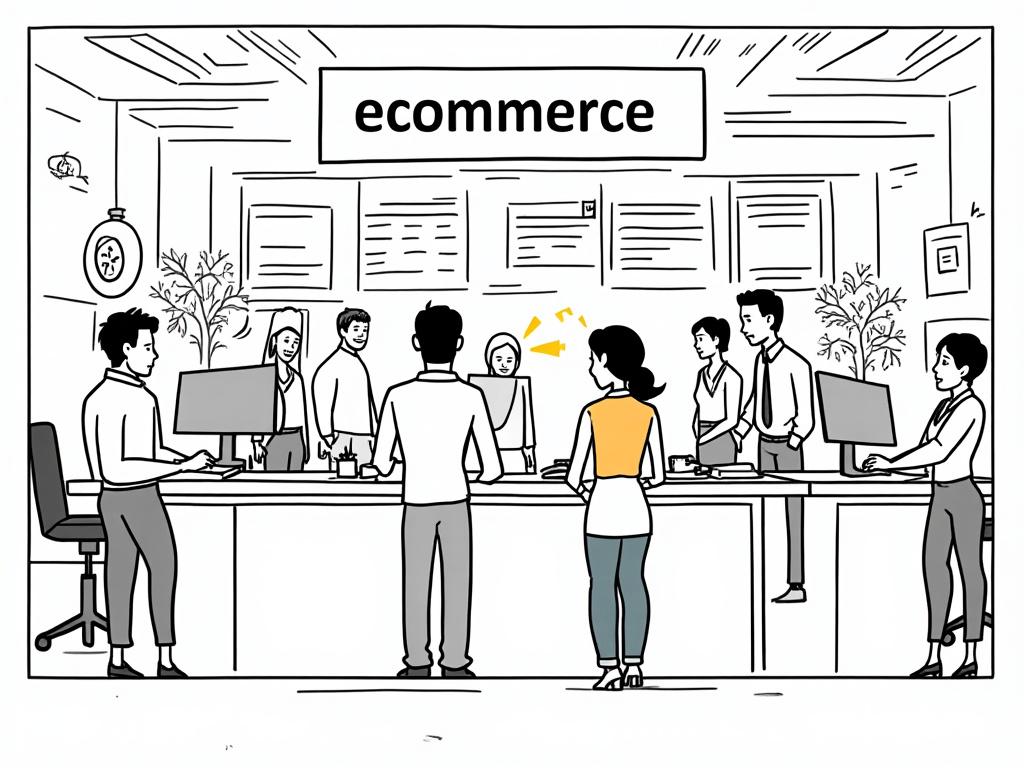
How to Start an Ecommerce Business: A Comprehensive Guide for 2025
Reading time: 12 minutes
Table of Contents
- What is an Ecommerce Business?
- How to Start an Ecommerce Business in 10 Steps
- Investment Breakdown: What You’ll Actually Spend
- 5 Battle-Tested Tips for Ecommerce Success
- Frequently Asked Questions
- Your 90-Day Launch Roadmap
What is an Ecommerce Business?
Ever wondered why global ecommerce sales hit **$5.8 trillion** in 2023? The answer lies in the fundamental shift of how consumers shop and businesses operate. An ecommerce business is essentially any commercial transaction conducted electronically over the internet—but here’s the straight talk: it’s become the backbone of modern commerce.
Think beyond just “selling stuff online.” Today’s ecommerce encompasses four distinct models:
**Business-to-Consumer (B2C):** The classic model where companies sell directly to individual customers. Amazon’s retail operations exemplify this approach.
**Business-to-Business (B2B):** Companies selling to other businesses, often involving bulk orders and specialized products. Alibaba dominates this space with over $1.3 trillion in annual transaction volume.
**Consumer-to-Consumer (C2C):** Individuals selling to other individuals through platforms like eBay or Facebook Marketplace.
**Consumer-to-Business (C2B):** Individuals providing services or products to businesses, such as freelance platforms or influencer marketing.
The beauty of ecommerce lies in its accessibility—you can start with minimal overhead and scale globally. Consider Sarah Chen, who launched her handmade jewelry business from her kitchen table in 2022. Within 18 months, she’s generating $40,000 monthly revenue across three continents, something impossible with traditional retail.
How to Start an Ecommerce Business in 10 Steps
Step 1: Identify Your Profitable Niche
Here’s where most aspiring entrepreneurs stumble—they chase broad markets instead of focusing on specific problems. Successful niches combine three elements: personal passion, market demand, and profit potential.
**Quick Scenario:** Instead of “selling fitness equipment,” consider “ergonomic home office fitness solutions for remote workers.” This targets a specific pain point with a defined audience willing to pay premium prices.
Use these validation techniques:
• Google Trends analysis for search volume
• Amazon bestseller research in your category
• Social media group discussions around pain points
• Competitor pricing analysis
Step 2: Conduct Strategic Market Research
Effective market research isn’t about surveys—it’s about understanding buyer behavior. Focus on these critical areas:
**Customer Avatar Development:** Create detailed profiles including demographics, psychographics, and shopping behaviors. Tools like Facebook Audience Insights provide invaluable data.
**Competitive Intelligence:** Analyze your top 3-5 competitors’ pricing strategies, marketing messages, and customer reviews. What complaints appear repeatedly? Those are your opportunities.
**Market Size Assessment:** Use tools like SEMrush or Ahrefs to estimate search volumes for your target keywords. A healthy niche shows 10,000+ monthly searches with manageable competition.
Step 3: Create Your Strategic Business Plan
Skip the 50-page business plan nobody reads. Focus on these essential elements:
• **Value Proposition:** One sentence explaining why customers choose you
• **Revenue Model:** How you’ll make money (product sales, subscriptions, services)
• **Financial Projections:** Conservative 12-month revenue and expense forecasts
• **Growth Strategy:** How you’ll scale from startup to sustainable business
Pro Tip: Use the lean canvas model—it fits on one page and forces clarity over complexity.
Step 4: Choose Your Business Model Wisely
Your business model determines everything from inventory management to profit margins. Here’s the reality check:
**Dropshipping:** Low startup costs but thin margins (10-20%) and limited control
**Private Label:** Higher investment but better margins (40-60%) and brand control
**Digital Products:** Highest margins (80-90%) but requires expertise creation
**Subscription Box:** Predictable revenue but complex logistics
Consider Jake Miller’s experience: He started dropshipping phone accessories, struggled with 15% margins, then pivoted to private label phone cases. His margins jumped to 50%, enabling reinvestment in marketing and growth.
Step 5: Select Your Ecommerce Platform
Platform choice impacts your long-term success more than most realize. Here’s the strategic breakdown:
| Platform | Best For | Monthly Cost | Customization | Scalability |
|---|---|---|---|---|
| Shopify | General ecommerce | $29-$299 | High | Excellent |
| WooCommerce | WordPress users | $10-$50 | Very High | Good |
| BigCommerce | Growing businesses | $29-$399 | High | Excellent |
| Squarespace | Design-focused brands | $18-$40 | Medium | Limited |
| Wix | Beginners | $23-$49 | Medium | Limited |
Step 6: Build Your High-Converting Store
Your website isn’t just a catalog—it’s your sales team working 24/7. Focus on these conversion-critical elements:
**Homepage Strategy:** Clear value proposition, hero image, and navigation within 5 seconds
**Product Pages:** High-quality images, detailed descriptions, customer reviews, and urgency elements
**Checkout Process:** Single-page checkout reduces abandonment by 35%
**Mobile Optimization:** 54% of ecommerce traffic comes from mobile devices
Real example: Emma Rodriguez increased her conversion rate from 1.2% to 4.1% simply by adding customer reviews and improving product image quality.
Step 7: Integrate Payment and Shipping Solutions
Payment processing affects your cash flow and customer trust. Consider these factors:
**Payment Gateways:** Stripe (2.9% + 30¢), PayPal (2.9% + fixed fee), Square (2.6% + 10¢)
**International Payments:** Essential if targeting global markets
**Shipping Strategy:** Offer multiple options including expedited shipping
**Returns Policy:** Clear, customer-friendly policies increase trust and sales
Step 8: Implement SEO from Day One
SEO isn’t optional—it’s how customers find you without paid advertising. Focus on:
• **Keyword Research:** Target long-tail keywords with buying intent
• **On-Page Optimization:** Title tags, meta descriptions, and URL structure
• **Content Marketing:** Blog posts addressing customer questions
• **Technical SEO:** Site speed, mobile responsiveness, and secure connections
Step 9: Develop Your Multi-Channel Marketing Strategy
Successful ecommerce businesses don’t rely on single marketing channels. Build your marketing mix:
**Organic Social Media:** Instagram and TikTok for visual products, LinkedIn for B2B
**Paid Advertising:** Start with Facebook/Instagram ads, expand to Google Ads
**Email Marketing:** Average ROI of $42 for every $1 spent
**Influencer Partnerships:** Micro-influencers often provide better ROI than mega-influencers
Step 10: Establish Exceptional Customer Service
Customer service directly impacts your bottom line—acquiring new customers costs 5x more than retaining existing ones. Implement:
• **Live Chat:** Increases conversions by 20%
• **FAQ Section:** Reduces support tickets by 30%
• **Response Time Goals:** Aim for under 2 hours for email, under 1 minute for chat
• **Feedback Loops:** Regular customer surveys and review monitoring
Investment Breakdown: What You’ll Actually Spend
Let’s cut through the “start for $100” myths and examine realistic startup costs for 2025:
Startup Cost Comparison by Business Model
**Monthly Operating Expenses:**
• Platform fees: $29-$299
• Apps and tools: $50-$200
• Marketing budget: $500-$2,000
• Inventory (if applicable): $1,000-$5,000
• Professional services: $200-$800
**Hidden Costs to Consider:**
• Product photography: $500-$2,000
• Legal setup (LLC, trademarks): $500-$1,500
• Insurance: $200-$800 annually
• Accounting software: $20-$50 monthly
5 Battle-Tested Tips for Ecommerce Success
Tip 1: Build on Rock-Solid Foundations
Strong foundations aren’t glamorous, but they’re everything. This means:
**Legal Structure:** Choose the right business entity (LLC offers liability protection with tax flexibility)
**Financial Systems:** Separate business and personal finances from day one
**Operational Processes:** Document everything—from order fulfillment to customer service protocols
**Quality Standards:** Establish non-negotiable quality criteria for products and services
Tip 2: Obsess Over User Experience
User experience determines whether visitors become customers. Focus on:
• **Page Load Speed:** Target under 3 seconds (use tools like GTmetrix)
• **Navigation Clarity:** Customers should find any product within 3 clicks
• **Trust Signals:** Security badges, customer reviews, clear contact information
• **Mobile Experience:** Test your site on multiple devices and screen sizes
Case study: Athletic wear brand Gymshark reduced their bounce rate from 68% to 41% by improving site speed and mobile navigation, resulting in a 23% increase in conversions.
Tip 3: Create Genuine Brand Loyalty
Brand loyalty isn’t built through discounts—it’s earned through consistent value delivery. Strategies that work:
**Community Building:** Create Facebook groups or Discord servers around your niche
**Content Value:** Provide educational content beyond product promotion
**Personal Connection:** Share your brand story and values authentically
**Surprise and Delight:** Unexpected bonuses or personalized notes with orders
Tip 4: Design for Scalability from Start
Plan for success by building scalable systems:
• **Automated Workflows:** Use tools like Zapier to connect your apps
• **Inventory Management:** Implement systems before you need them
• **Team Structure:** Define roles and responsibilities for future hires
• **Financial Planning:** Maintain 3-6 months of operating expenses in reserve
Tip 5: Test Everything, Assume Nothing
Successful ecommerce entrepreneurs are skilled experimenters. Test:
**Product Pricing:** A/B test different price points
**Marketing Messages:** Try different value propositions
**Website Elements:** Headlines, button colors, product descriptions
**Marketing Channels:** Allocate budget across multiple channels, then double down on winners
Pro Tip: Use the 70-20-10 rule—70% of budget on proven strategies, 20% on promising experiments, 10% on wild cards.
Frequently Asked Questions
How much does it realistically cost to start an ecommerce business?
The honest answer depends on your business model and ambition level. For a basic dropshipping store, expect $500-$2,000 initially, plus $500-$1,000 monthly operating costs. Private label businesses require $5,000-$15,000 upfront for inventory and branding. Digital product businesses can start for under $1,000 but require significant time investment in content creation. The key is starting lean and reinvesting profits into growth rather than taking on excessive debt.
Do I need an LLC for my ecommerce business?
While not legally required, forming an LLC provides crucial liability protection and tax advantages. An LLC separates your personal assets from business debts and lawsuits—essential when dealing with product liability or customer disputes. Additionally, LLCs offer tax flexibility, allowing you to choose how you’re taxed. The process costs $50-$500 depending on your state, making it a worthwhile investment for serious entrepreneurs. Consider consulting with a business attorney for personalized advice.
What skills do I actually need to run an ecommerce business?
Successful ecommerce requires a blend of technical and business skills, but you don’t need to master everything immediately. Essential skills include: basic digital marketing (social media, email marketing), customer service excellence, financial management, and problem-solving abilities. Technical skills like web design and SEO can be learned or outsourced. The most important skill is adaptability—ecommerce evolves rapidly, and successful entrepreneurs continuously learn and adjust their strategies based on data and market feedback.
Your 90-Day Launch Roadmap
Ready to transform your ecommerce dreams into reality? Here’s your strategic 90-day action plan:
**Days 1-30: Foundation Phase**
• Complete market research and validate your niche
• Create your business plan and legal structure
• Choose and set up your ecommerce platform
• Source initial products or create digital offerings
• Design your brand identity and basic website
**Days 31-60: Build Phase**
• Complete website development with essential pages
• Set up payment processing and shipping solutions
• Create your first marketing materials and content
• Establish social media presence across chosen platforms
• Begin building your email list with lead magnets
**Days 61-90: Launch Phase**
• Conduct soft launch with friends and family for feedback
• Implement SEO basics and submit sitemap to search engines
• Launch paid advertising campaigns with small budgets
• Execute your grand opening marketing strategy
• Monitor analytics and optimize based on early data
**Beyond 90 Days: Scale Phase**
Focus on customer retention, expand your product line, and reinvest profits into proven marketing channels. Remember, successful ecommerce isn’t about perfection—it’s about consistent improvement and customer value creation.
The ecommerce landscape will continue evolving with AI integration, voice commerce, and augmented reality shopping experiences. Position yourself now to capitalize on these emerging trends while building a sustainable, profitable business.
What’s the first step you’ll take today to move from dreaming about your ecommerce business to actually building it? Your future customers are waiting for the unique value only you can provide.

Article reviewed by Emma van der Berg, Sustainability Analyst | Researching Green Energy Projects, on June 16, 2025
